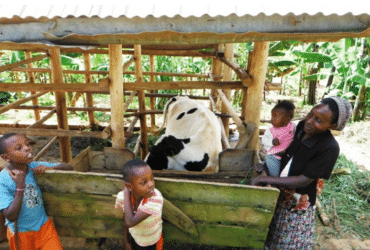Peragia Nansikombi and her husband are the parents of seven children. She today gives credit to the living loan of her cow for keeping her family together. Peragia was faced with the reality that the family would need to split up to survive and meet even their most basic needs. They had no source of income and not enough food to eat. However, in 2016, Peragia heard about the Microfinancing Partners in Africa cow project and knew immediately that this could be exactly what her family needed.
Before receiving our cow, the relationship with my husband was very strained because of financial instability. He could not provide basic needs for our family. We were considering splitting the family up amongst extended family and neighbors until we could support all our children all under one roof again. One fateful day, I heard about the cow project that gives cows in Masaka Diocese after you complete training and build a proper structure for housing/sanitation for the cow.
Having a cow would provide my family with so many benefits, we could earn income by selling the milk as well as have milk to supplement our daily diets. It took some time to convince my husband. Once he saw and understood the benefits, we gathered supplies and constructed a cow a shed while we attending trainings in sustainable agriculture and livestock management. After we completed the requirements, we received our first an in-calf heifer. It produces 15 liters daily from which we drink and sell the remainder within our community. Having this income allows for us to pay for basic needs, send our children to school and even complete some home improvements, such as: install a water tank worth UGX 350,000 ($94.50 USD), setup a piggery and poultry project which has also supplemented our household income.
We “passed on” our first female heifer to a neighbor in the program in 2018, therefore, and intend to keep any other female heifers to expand our farm and increase milk production. The production of the cow’s manure has helped improve the quality and quantity of crops we grow, which has created surplus food to sell and be a second revenue stream. Now we can afford to have three meals a day supplemented with fruits and vegetables from our kitchen gardens.

